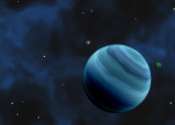Astronomers detect possible radio emission from exoplanet
By monitoring the cosmos with a radio telescope array, a Cornell University-led international team of scientists has detected radio bursts emanating from the constellation Boötes. The signal could be the first radio emission ...









